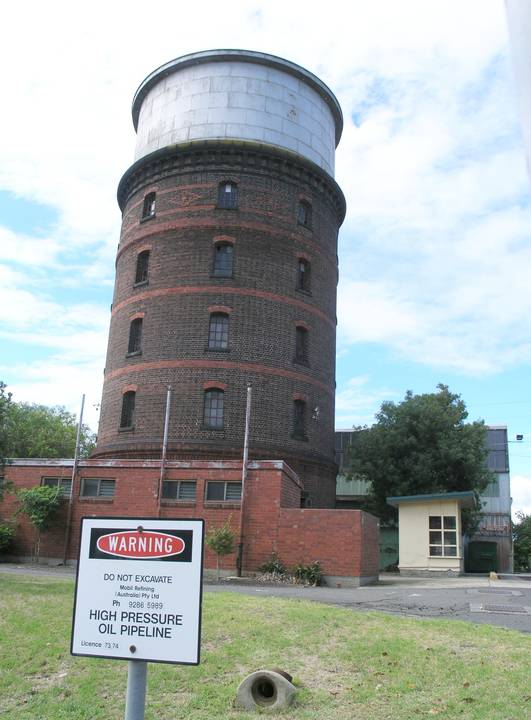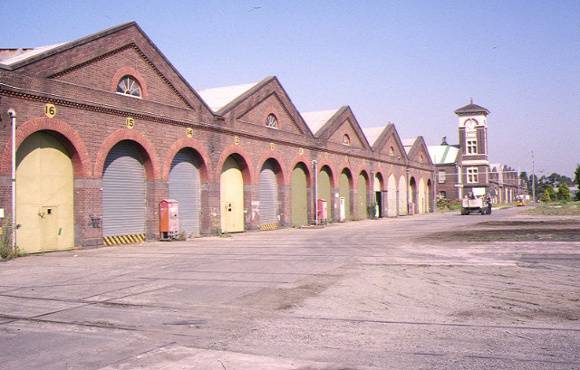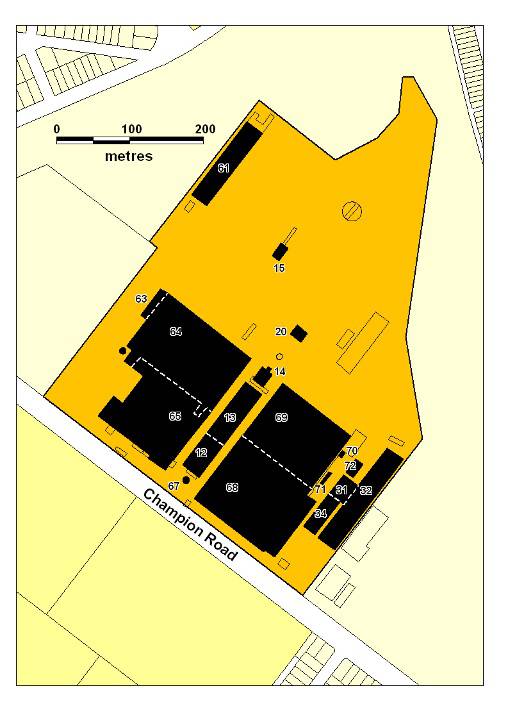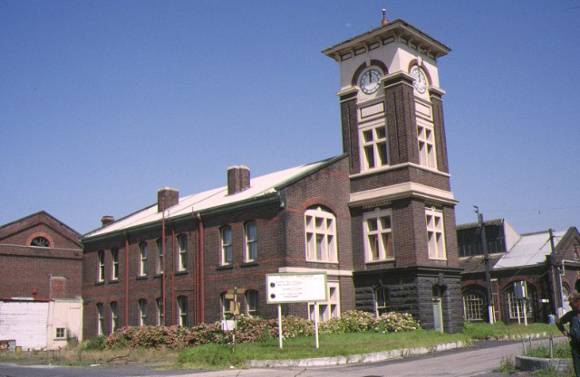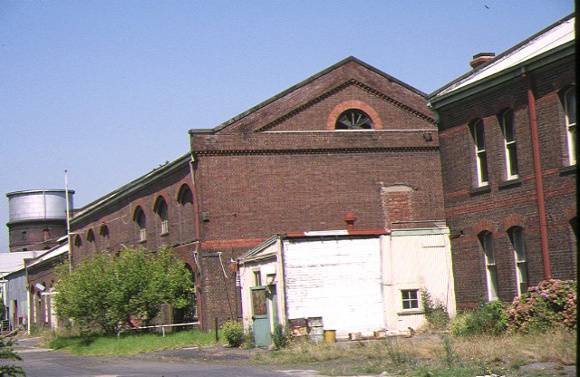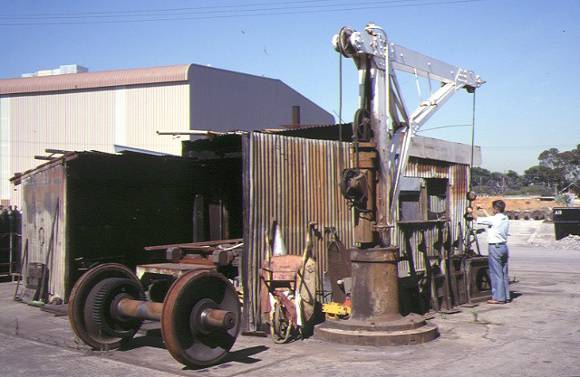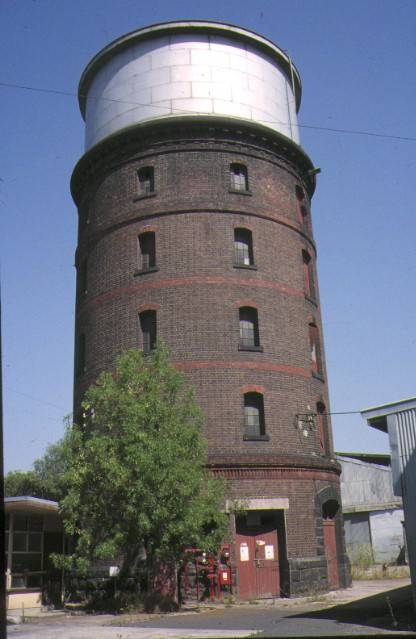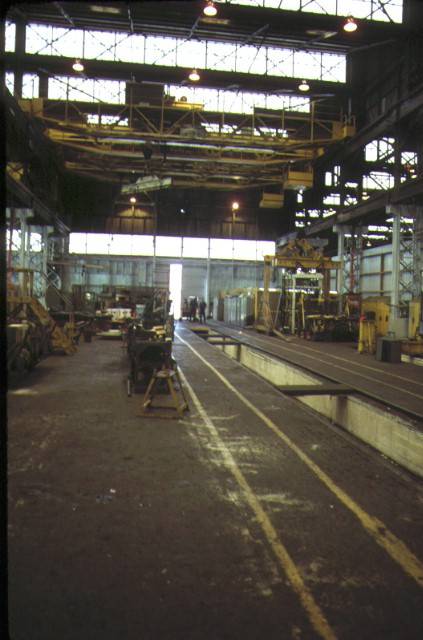| Back to search results » | Back to search page » |
|
FORMER NEWPORT RAILWAY WORKSHOPS
Location2-78 CHAMPION ROAD NEWPORT, HOBSONS BAY CITY
File Number10/028504 [1-3] [closed]LevelRegistered |
|
Statement of Significance
What is significant?
In 1884 the decision was made to erect a new workshop facility in an area of land between the Geelong Railway and the Williamstown Railway at Newport (the current Workshops site). Although the original intent was that the workshop would undertake all maintenance of rolling stock, leaving private enterprise with the role of constructing rolling stock, it was undermined from the start with the construction of rolling stock (mainly passenger carriages).
Reputedly based on the design of British railway workshops, the design for the Workshop was extensively modified by the Victorian engineers, Breretin and Lewis. The new complex was constructed and equipped in 1886 - 88. The main elements of the 1888 group comprises a Central Block of offices with clock tower, a large water tower at the rear of the site fronting Champion Road, a Central Block housing stores, patterns and certain brass and copper fittings, the East Block for repair and maintenance of wooden passenger carriages and goods wagons, and the West Block for the heavy engineering activities of the repair and maintenance of locomotives, boilers and metal components of goods wagons. The layout was typical of a pre-production line facility where parts were fabricated and then moved to a central area where the item was assembled. The major problem of the lack of run-around tracks is evident in the design with both East and West Blocks having dead ends and only Central Block having a proper shunting neck.
In the northern section of the site was the Tarpaulin Shed, constructed in 1887 and doubled in size with a virtually identical extension in 1890, to manufacture and repair tarpaulins used to cover perishable loads on goods wagons.
The period of 1902 - 1915 saw a major expansion of the Newport Workshops, with corrugated iron extensions being added to some of the 1888 brick buildings to double the area of enclosed workshops. The Victorian Railways began a program of continual modernisation of its operations from the turn of the century and these involved the Newport Workshops in construction of new rolling stock; conversion of passenger carriages to electric motors and trailers and the replacement of buffers with auto couplers. As well, most of the locomotives acquired at that time were produced at Newport Workshops (including the first electric locomotives).
The Railways' move towards the manufacture of locomotives, combined with the increasing use of metals in production, resulted in the need to expand West Block. After 1915, the lack of space at West Block became a major issue. Consequently, in the late 1920s, the construction of purpose built locomotive production facilities was undertaken between the Newport Railway Workshops and the Williamstown line with the resultant staff increases making this one of the largest workshops in Victoria.
The Depression and the Second World War was a period of limited expenditure on the Railways with a highlight being construction of the Spirit of Progress. Newport Workshops was an important centre of wartime production. Apart from contributing through construction of new locomotives and rolling stock to improve the efficiency of land transportation, the Workshops were a centre for the production for the Australian Standard Garratt, Bren Gun Carriers and for the Beaufort/Beaufighter program. Labour shortages resulted in the workforce being comprised of some 35% women, probably the largest number of women that ever worked at Newport.
In the post-war period, Operation Phoenix was launched to rehabilitate the railways and Newport was no longer involved in locomotive construction. The introduction of low maintenance, diesel locomotives and metal-bodied carriages, the purchase of more rail vehicles and supplies from commercial manufacturers, and the trend away from rail to road traffic brought a decline in workshop activities and staff. Railway workshop functions have recently been concentrated in a group of c.1927 and newer buildings on the eastern part of the site. The original 1888 group of buildings continued in workshop use until 1992.
How is it significant?
The former Newport Railway Workshops are of historical, scientific and architectural significance to the state of Victoria.
Why is it significant?
The 1888 group of buildings forming the original Newport Railway Workshops have historical significance as one of the best surviving 19th century railway workshops in the world, and one of Australia's most outstanding items of industrial heritage. The Newport workshops were the Victorian Railway's main workshops for just over a century. The later buildings reflecting growth, particularly during 1902-1928 in the period of modernisation, expansion and the production of locomotives, demonstrate this subsequent important period of development. For many of those years the Workshops were one of the Victoria's largest and best equipped engineering establishments, with up to 5,000 employees on site, building and maintaining steam locomotives and other rolling stock, and also making tarpaulins and other basic stores for railway use. Newport Workshops even made many of its own machine tools, a task which required a high level of technical expertise. Newport Workshops was also an important centre of World War Two production.
The 1888 group of buildings at Newport Railway Workshops have architectural significance for their large scale and the high quality of their design and construction. These qualities of the Workshops reflect the transition from ad hoc management of the railways to the establishment of a railways system. They demonstrate the determination of the Victorian Railways management to have the best possible workshop facilities, which in turn reflects the prevailing spirit of confidence and optimism in a period of great wealth and growth in the Victorian Railways and in Victoria generally. The northern facades of the 1888 group were the Workshop's frontage to Melbourne and feature wings of gabled bays flanking the central, three storey Italianate style clocktower. Decorative detailing to the brickwork includes corbelled pediments, and bi-chromatic highlights to the arcaded doorways and fanlight windows.
The 1887 and 1890 sections of the Tarpaulin Shop were similarly detailed, though the 1912 northern extension has enclosed this facade. The vast interior of the Tarpaulin Shop, with a roof supported by massive timber trusses and columns, is of architectural significance. This unusual and impressive space was determined by the need for hanging space.
Part of the West Block Southern Extension, known as the Fitting Shop Extension and South of Fitting Shop Extension are of architectural significance because they are likely to have been sections of the Williamstown Workshops re-erected at Newport in 1897. They provide an important physical link to the earlier Workshops. The distinctive trusses of these sections and the unusual pole construction of the Boiler Shop Extension are of architectural significance.
The form of the Timber Store building is of architectural significance. It is not known why two decorative clerestory lanterns are incorporated in the roof but one theory is that it is a rare surviving shed from the 1880 International Exhibition in Melbourne. Further work is required to substantiate this potentially very important link.
The buildings reflecting the period of expansion up until 1928 are also of architectural significance for their contrast with the earlier vision. They include early examples of modern industrial construction, including large span trusses enabling expansive working space, and south-facing saw tooth roofs providing light spaces. With repetitive construction units and ease of erection, these buildings demonstrate an industrial functionality in contrast to the architectural pretension of the earlier group.
The Newport Railway Workshops are of scientific significance for their research potential with regard to the technology demonstrated in the remaining machinery and evidence of work practices.
Building 12 Central Block Extensions
Building 12 is of historical and architectural significance to the state of Victoria. Built in 1909 as a substantially intact, large addition to the iron foundry, it demonstrates the important historical theme of the great expansion of the Newport Workshops, between 1902 and 1928. Its modern industrial construction is in contrast to the architectural style of the 1888 Central Block Stores.
Building 12 is of historical and architectural significance to the state of Victoria. Built in 1909 as a substantially intact, large addition to the iron foundry, it demonstrates the important historical theme of the great expansion of the Newport Workshops, between 1902 and 1928. Its modern industrial construction is in contrast to the architectural style of the 1888 Central Block Stores.
Building 13 Central Block Stores
Building 13 is of historical and architectural significance to the state of Victoria. The original brick Central Block was constructed in 1888, followed in 1890 by the corrugated iron clad brass foundry extensions. The Building originally contained stores, pattern shop, tinsmith's and coppersmith's shop and a brass foundry. The Block was later used as a general store, stores office and plant repair shop.
The 1888 Central Block is a major element of the original 1888 group of buildings which complements and links the East and West Blocks visually and functionally (particularly in its stores function, which allowed easy distribution of stores the full width of the East and West Blocks via cross trolleys).
The 1890 foundry, constructed very soon after the 1888 buildings, was probably built in response to an important and early change of plans for the function of the main West Block. It reflects a very early change from lavish to economical building styles.
The building is virtually intact and is an increasingly rare example of the use of cast-iron columns. There is considerable evidence of past line-shafting and other signs of its former uses.
Building 13 is of historical and architectural significance to the state of Victoria. The original brick Central Block was constructed in 1888, followed in 1890 by the corrugated iron clad brass foundry extensions. The Building originally contained stores, pattern shop, tinsmith's and coppersmith's shop and a brass foundry. The Block was later used as a general store, stores office and plant repair shop.
The 1888 Central Block is a major element of the original 1888 group of buildings which complements and links the East and West Blocks visually and functionally (particularly in its stores function, which allowed easy distribution of stores the full width of the East and West Blocks via cross trolleys).
The 1890 foundry, constructed very soon after the 1888 buildings, was probably built in response to an important and early change of plans for the function of the main West Block. It reflects a very early change from lavish to economical building styles.
The building is virtually intact and is an increasingly rare example of the use of cast-iron columns. There is considerable evidence of past line-shafting and other signs of its former uses.
Building 14 Central Block (Offices)
Building 14 is of historical and architectural significance to the state of Victoria. This building was constructed 1886 - 88 as offices for the engineer, store keeper, accountant and their respective staff.
The 1888 Central Block offices and three storey Italianate style clock tower is the visual and operational focal point of the original and highly significant, 1888 group of buildings. It was constructed as prestige offices of high architectural quality and is virtually intact.
The northern facades of the 1888 group of buildings were the Workshop's frontage to Melbourne and the central, three storey Italianate style clocktower is the key architectural pivot in the design, flanked by wings of gabled bays.
The clock tower, near the centre of the site, is characteristic of 19th century factories and workshops, where working hours were strict and when few employees wore watches. The mechanical, wind-up mechanism of the clock appears to be original.
Building 14 is of historical and architectural significance to the state of Victoria. This building was constructed 1886 - 88 as offices for the engineer, store keeper, accountant and their respective staff.
The 1888 Central Block offices and three storey Italianate style clock tower is the visual and operational focal point of the original and highly significant, 1888 group of buildings. It was constructed as prestige offices of high architectural quality and is virtually intact.
The northern facades of the 1888 group of buildings were the Workshop's frontage to Melbourne and the central, three storey Italianate style clocktower is the key architectural pivot in the design, flanked by wings of gabled bays.
The clock tower, near the centre of the site, is characteristic of 19th century factories and workshops, where working hours were strict and when few employees wore watches. The mechanical, wind-up mechanism of the clock appears to be original.
Building 15 Engine Balancing Tables
Building 15 is of historical significance to the state of Victoria. The engine balancing tables are located under the open-sided shed, Building 15. The engine balancing tables were built in 1912 by Henry Pooley & Son Ltd, Birmingham and comprise a series of 7 mechanical weighing scales set in line in a pit with each scale supporting a short length of train track. Each weighing unit has a cast iron box alongside, containing counterweights and levers, and a curved scale calibrated to 12 tons. A locomotive or carriage was positioned on the rails above the scales to be weighed. The engine balancing tables were designed to measure the load on each wheel of a steam locomotive simultaneously so that adjustments could be made to give the correct weight distribution on each axle.
In 1918, the Victorian Railways owned three balancing tables. The Newport example is the only known surviving example of engine balancing tables in Victoria.
Building 15 is of historical significance to the state of Victoria. The engine balancing tables are located under the open-sided shed, Building 15. The engine balancing tables were built in 1912 by Henry Pooley & Son Ltd, Birmingham and comprise a series of 7 mechanical weighing scales set in line in a pit with each scale supporting a short length of train track. Each weighing unit has a cast iron box alongside, containing counterweights and levers, and a curved scale calibrated to 12 tons. A locomotive or carriage was positioned on the rails above the scales to be weighed. The engine balancing tables were designed to measure the load on each wheel of a steam locomotive simultaneously so that adjustments could be made to give the correct weight distribution on each axle.
In 1918, the Victorian Railways owned three balancing tables. The Newport example is the only known surviving example of engine balancing tables in Victoria.
Building 31 Timber Store
Building 31 is of historical and architectural significance to the state of Victoria. Constructed and altered between 1898 and 1913, this building was believed to be a timber bending and drying shop, where timbers used in carriage construction were formed until about the mid 1900s when it changed to a timber store.
The form of the building is of architectural significance. It is not known why two decorative clerestory lanterns are incorporated in the roof but one theory is that it is a rare surviving shed from the 1880 International Exhibition in Melbourne. Further work is required to substantiate this potentially very important link.
The Timber Store is of historical significance as a building dating from 1898, with alterations until 1913, which performed a vital function as part of the Workshop for approximately 80 years.
Building 31 is of historical and architectural significance to the state of Victoria. Constructed and altered between 1898 and 1913, this building was believed to be a timber bending and drying shop, where timbers used in carriage construction were formed until about the mid 1900s when it changed to a timber store.
The form of the building is of architectural significance. It is not known why two decorative clerestory lanterns are incorporated in the roof but one theory is that it is a rare surviving shed from the 1880 International Exhibition in Melbourne. Further work is required to substantiate this potentially very important link.
The Timber Store is of historical significance as a building dating from 1898, with alterations until 1913, which performed a vital function as part of the Workshop for approximately 80 years.
Building 32 Timber Shed
Building 32 is of historical and architectural significance to the state of Victoria. This building was part of the Carriage Workshops established prior to this Newport site, on the north side of the Melbourne - Williamstown line. It was then known as the Stacking Shed, built c1883, and was demolished and re-erected for use as a Timber Shed in its present location in c1905.
The Timber Shed is of historical significance as the only discrete building to survive from the original Carriage Workshops of 1882/83, which predated the more permanent and more extensive c1888 Newport Workshops development.
The timber frame is the oldest known discrete structure at Newport Workshops. Despite the renewal of the iron cladding, the basic structure, form and function of the Timber Shed have survived relatively unaltered after more than 100 years.
It reflects the importance of a large timber drying and seasoning area on site at a time when much high quality timber was used in carriage making. It has functioned as a timber shed in its present location for more than 80 years.
Building 32 is of historical and architectural significance to the state of Victoria. This building was part of the Carriage Workshops established prior to this Newport site, on the north side of the Melbourne - Williamstown line. It was then known as the Stacking Shed, built c1883, and was demolished and re-erected for use as a Timber Shed in its present location in c1905.
The Timber Shed is of historical significance as the only discrete building to survive from the original Carriage Workshops of 1882/83, which predated the more permanent and more extensive c1888 Newport Workshops development.
The timber frame is the oldest known discrete structure at Newport Workshops. Despite the renewal of the iron cladding, the basic structure, form and function of the Timber Shed have survived relatively unaltered after more than 100 years.
It reflects the importance of a large timber drying and seasoning area on site at a time when much high quality timber was used in carriage making. It has functioned as a timber shed in its present location for more than 80 years.
* Building 34 The Plating Shop
Building 34 is of historical, scientific and architectural significance to the state of Victoria. Built in 1912, this building houses the original 1888 cesspit which drains the water from underneath East Block. The function of this building varied over time from Steam Bending of timber for carriage bodywork in the northern section (c1928), to Electroplating (including Nickel Plating) in the southern section (1912), Locksmiths Shop (c1928), and Car Fitting Shop (c1979). The electroplating process involves application of a protective or decorative electroplating to metal components made at Newport Workshops.
The Plating Shop was part of the period of expansion of the Newport Workshops, 1902-1915. Its changing function indicates the declining role of timber bending, and the long standing and growing role of electroplating at Newport Workshops. It has been used as an electroplating shop, throughout its life of more than 75 years, and retains evidence of work practices. Further work is required to establish its research potential.
Building 34 is of historical, scientific and architectural significance to the state of Victoria. Built in 1912, this building houses the original 1888 cesspit which drains the water from underneath East Block. The function of this building varied over time from Steam Bending of timber for carriage bodywork in the northern section (c1928), to Electroplating (including Nickel Plating) in the southern section (1912), Locksmiths Shop (c1928), and Car Fitting Shop (c1979). The electroplating process involves application of a protective or decorative electroplating to metal components made at Newport Workshops.
The Plating Shop was part of the period of expansion of the Newport Workshops, 1902-1915. Its changing function indicates the declining role of timber bending, and the long standing and growing role of electroplating at Newport Workshops. It has been used as an electroplating shop, throughout its life of more than 75 years, and retains evidence of work practices. Further work is required to establish its research potential.
Building 61 Tarpaulin Shop
Building 61 is of historical and architectural significance to the state of Victoria. The original Tarpaulin Shop was built by H Maxwell in 1887 and the south extension, virtually identical with the original, was constructed in 1890. In 1912 the building was again doubled in size.
The 1887 portion is, and the 1890 portion can be considered as, part of the original high-quality c.1888 group of permanent buildings. Like other buildings in the group, it includes decorative brickwork detailing to the north wall, the front of the Workshops which is now enclosed in the 1912 northern extension. The need for hanging space has determined the unusual proportions of the Tarpaulin Shop. Its vast interior is supported by massive timber trusses and columns creating an impressive space.
The size and specialised design of the building demonstrates the importance of tarpaulin manufacture and repair. The building is substantially intact and the sequence of expansion can be clearly understood.
The building is of historical significance as the earliest part of the building was used as a tarpaulin shop for about ninety years, from 1888 to c.1980. The 1912 northern addition was part of the major period of expansion of the Workshops 1902-1915, and typifies the emphasis on low-cost construction in comparison to the more lavish c1888 building program.
The addition had an early form of sawtooth roof, oddly concealed behind false gables. The addition demonstrates the continuing and growing workload of tarpaulin manufacture and repair at that time.
The addition continued to be used as a Tarpaulin Shop for about 65-70 years.
Building 61 is of historical and architectural significance to the state of Victoria. The original Tarpaulin Shop was built by H Maxwell in 1887 and the south extension, virtually identical with the original, was constructed in 1890. In 1912 the building was again doubled in size.
The 1887 portion is, and the 1890 portion can be considered as, part of the original high-quality c.1888 group of permanent buildings. Like other buildings in the group, it includes decorative brickwork detailing to the north wall, the front of the Workshops which is now enclosed in the 1912 northern extension. The need for hanging space has determined the unusual proportions of the Tarpaulin Shop. Its vast interior is supported by massive timber trusses and columns creating an impressive space.
The size and specialised design of the building demonstrates the importance of tarpaulin manufacture and repair. The building is substantially intact and the sequence of expansion can be clearly understood.
The building is of historical significance as the earliest part of the building was used as a tarpaulin shop for about ninety years, from 1888 to c.1980. The 1912 northern addition was part of the major period of expansion of the Workshops 1902-1915, and typifies the emphasis on low-cost construction in comparison to the more lavish c1888 building program.
The addition had an early form of sawtooth roof, oddly concealed behind false gables. The addition demonstrates the continuing and growing workload of tarpaulin manufacture and repair at that time.
The addition continued to be used as a Tarpaulin Shop for about 65-70 years.
Building 64 West Block & Building 63 Spring Shop Extension (including the attached East and West Engine Houses, and the West Engine House Chimney Base).
Buildings 63 and 64 are of historical and architectural significance to the state of Victoria. The original West Block building was built by W Swanson C.1885-86 and the West Block chimneys and flues were erected by R Bodkin in 1888. In c1904, the Spring Shop Extension was added. The west tower was used for metalworking activities such as metal machining and turning, boilermaking, blacksmithing, and the construction and maintenance of locomotives. During the Second World War the West Block was used for the complete or partial manufacture of Bren Gun Carriers, and the Australian Standard Garratt.
The 1888 West Block with the c1904 Spring Shop Extension is a major element of the original and highly significant 1888 group of buildings and complements and balances the East Block visually and functionally. The northern facades of the 1888 group were the Workshop's frontage to Melbourne and feature wings of gabled bays flanking the central, three storey Italianate style clocktower. Decorative detailing to the brickwork includes corbelled pediments, and bi-chromatic highlights to the arcaded doorways and fanlight windows.
The West Block housed all the machining and heavy metalwork functions without which the workshops could not have carried out its main role of building and maintaining locomotives, carriages and wagons. The design and layout of the building, and the movement and handling of rolling stock through the building was highly functional.
The building is substantially intact and is an increasingly rare example of the use of cast iron columns. The gabled brick facades demonstrate a high standard of craftsmanship. The double columns, the twin rope driven cranes, and the underfloor flue systems demonstrate impressive skills in design and function.
The principle contractor was from a family prominent in the building industry in Melbourne for many years.
The building was used continuously for the same basis function for over one hundred years.
West Block has important historical associations as the place of construction of some of the more famous locomotives built at Newport, including the first locomotive 'Polly' and the engines used on Puffing Billy.
The Spring Shop Extension is an early extension, with a long history of continuous use which demonstrates the important role of spring manufacture at Newport Workshops. It demonstrates the early overflow from the original 1888 buildings and the concern with maintaining the appearance of the northern face of the West Block, the front of the Workshops.
Buildings 63 and 64 are of historical and architectural significance to the state of Victoria. The original West Block building was built by W Swanson C.1885-86 and the West Block chimneys and flues were erected by R Bodkin in 1888. In c1904, the Spring Shop Extension was added. The west tower was used for metalworking activities such as metal machining and turning, boilermaking, blacksmithing, and the construction and maintenance of locomotives. During the Second World War the West Block was used for the complete or partial manufacture of Bren Gun Carriers, and the Australian Standard Garratt.
The 1888 West Block with the c1904 Spring Shop Extension is a major element of the original and highly significant 1888 group of buildings and complements and balances the East Block visually and functionally. The northern facades of the 1888 group were the Workshop's frontage to Melbourne and feature wings of gabled bays flanking the central, three storey Italianate style clocktower. Decorative detailing to the brickwork includes corbelled pediments, and bi-chromatic highlights to the arcaded doorways and fanlight windows.
The West Block housed all the machining and heavy metalwork functions without which the workshops could not have carried out its main role of building and maintaining locomotives, carriages and wagons. The design and layout of the building, and the movement and handling of rolling stock through the building was highly functional.
The building is substantially intact and is an increasingly rare example of the use of cast iron columns. The gabled brick facades demonstrate a high standard of craftsmanship. The double columns, the twin rope driven cranes, and the underfloor flue systems demonstrate impressive skills in design and function.
The principle contractor was from a family prominent in the building industry in Melbourne for many years.
The building was used continuously for the same basis function for over one hundred years.
West Block has important historical associations as the place of construction of some of the more famous locomotives built at Newport, including the first locomotive 'Polly' and the engines used on Puffing Billy.
The Spring Shop Extension is an early extension, with a long history of continuous use which demonstrates the important role of spring manufacture at Newport Workshops. It demonstrates the early overflow from the original 1888 buildings and the concern with maintaining the appearance of the northern face of the West Block, the front of the Workshops.
* Building 65 West Block Southern Extension
The whole of Building 65, except the Machine Shop Extension, is of historical, scientific and architectural significance to the state of Victoria. The Machine Shop Extension is of contributory significance.
The West Block Southern Extension is a collection of smaller buildings which grew incrementally and were enclosed as one structure from 1910 onwards. Because of the many changes in name and function, it is difficult to clearly date all the components. A 1913 list provides evidence that parts of the Williamstown Workshops were re-erected at Newport in 1897 within the West Block Southern Extension. The distinctive timber trusses of the Fitting Shop Extension and South of Fitting Shop Extension and the approximate areas involved mean that they may be these sections.
The Boiler Shop Extension, the Smithy Annexe and Fitting Shop Extension were already constructed by 1905. In c1908 the Hydraulic Riveter Shop was built and the Blacksmiths Extension was from the same year. The 1910 drawing of the roofing of the Truck Building Yard shows that the Air Compressor & Westinghouse Brake Shop was already in existence and was modified with the south wall removed and reinstated as part of the south wall of the Truck Building Yard at this time. The construction of the Machine Shop Extension is similar to the Truck Building Yard and it is believed to date from between 1915 and 1928. The likely evidence of earlier buildings is of archaeological potential although little may be learned which is not already understood from existing documentation.
The historical significance of the West Block Southern Extension is that, more than any other part of the Newport Workshops, it reflects the important change in role of the Workshops from the initial concept of maintenance of rolling stock to the manufacture of locomotives and the subsequent expansion this meant for the Workshops. This change, combined with the increasing use of metals in production, resulted in the need to expand West Block. The incremental growth of a number of small buildings between 1897 and 1928 is still demonstrated in the physical fabric. It was also the design limitations for expansion of West Block Southern Extension with Champion Road and the dead end track design which gave rise to the need for the construction of purpose built locomotive facilities in the late 1920s.
All of the components of West Block Southern Extension are of considerable age and the area was used continuously for the same Workshop function for 70-80 years; the Boiler Shop Extension c1905, the Smithy Annexe c1905, the Fitting Shop Extension c1905, the Hydraulic Riveter Shop c1908, the Blacksmiths Extension 1908, the Air Compressor & Westinghouse Brake Shop pre1910, the Truck Building Yard 1910 and the Machine Shop Extension between 1915 and 1928.
It is likely that the Fitting Shop Extension and South of Fitting Shop Extension were parts of the Williamstown Workshops re-erected at Newport in 1897. They provide an important physical link to the earlier Workshops. The distinctive trusses of these sections and the unusual pole construction of the Boiler Shop Extension are of architectural significance.
The West Block Southern Extension is a reasonably early example of sawtooth roof construction. The much taller gable roof sections are evidence of the use of hydraulic equipment, and especially a large gap riveter, in this area c1908. Remnant line shafting, bearings or motor mountings in the timber trusses provide evidence of past machinery layout.
The whole of Building 65, except the Machine Shop Extension, is of historical, scientific and architectural significance to the state of Victoria. The Machine Shop Extension is of contributory significance.
The West Block Southern Extension is a collection of smaller buildings which grew incrementally and were enclosed as one structure from 1910 onwards. Because of the many changes in name and function, it is difficult to clearly date all the components. A 1913 list provides evidence that parts of the Williamstown Workshops were re-erected at Newport in 1897 within the West Block Southern Extension. The distinctive timber trusses of the Fitting Shop Extension and South of Fitting Shop Extension and the approximate areas involved mean that they may be these sections.
The Boiler Shop Extension, the Smithy Annexe and Fitting Shop Extension were already constructed by 1905. In c1908 the Hydraulic Riveter Shop was built and the Blacksmiths Extension was from the same year. The 1910 drawing of the roofing of the Truck Building Yard shows that the Air Compressor & Westinghouse Brake Shop was already in existence and was modified with the south wall removed and reinstated as part of the south wall of the Truck Building Yard at this time. The construction of the Machine Shop Extension is similar to the Truck Building Yard and it is believed to date from between 1915 and 1928. The likely evidence of earlier buildings is of archaeological potential although little may be learned which is not already understood from existing documentation.
The historical significance of the West Block Southern Extension is that, more than any other part of the Newport Workshops, it reflects the important change in role of the Workshops from the initial concept of maintenance of rolling stock to the manufacture of locomotives and the subsequent expansion this meant for the Workshops. This change, combined with the increasing use of metals in production, resulted in the need to expand West Block. The incremental growth of a number of small buildings between 1897 and 1928 is still demonstrated in the physical fabric. It was also the design limitations for expansion of West Block Southern Extension with Champion Road and the dead end track design which gave rise to the need for the construction of purpose built locomotive facilities in the late 1920s.
All of the components of West Block Southern Extension are of considerable age and the area was used continuously for the same Workshop function for 70-80 years; the Boiler Shop Extension c1905, the Smithy Annexe c1905, the Fitting Shop Extension c1905, the Hydraulic Riveter Shop c1908, the Blacksmiths Extension 1908, the Air Compressor & Westinghouse Brake Shop pre1910, the Truck Building Yard 1910 and the Machine Shop Extension between 1915 and 1928.
It is likely that the Fitting Shop Extension and South of Fitting Shop Extension were parts of the Williamstown Workshops re-erected at Newport in 1897. They provide an important physical link to the earlier Workshops. The distinctive trusses of these sections and the unusual pole construction of the Boiler Shop Extension are of architectural significance.
The West Block Southern Extension is a reasonably early example of sawtooth roof construction. The much taller gable roof sections are evidence of the use of hydraulic equipment, and especially a large gap riveter, in this area c1908. Remnant line shafting, bearings or motor mountings in the timber trusses provide evidence of past machinery layout.
* Building 67 Water Tower
Building 67 is of historical and architectural significance to the state of Victoria. Built in 1888, it stored 100,000 gallons of water at high head, initially to supply fire fighting hydrants, and later the fire sprinkler system.
The Water Tower is a prominent component of the original 1888 group of buildings, complementing and balancing the Central Block Offices and Clock Tower. It demonstrates the high architectural and structural quality maintained in design and construction during the optimistic 'boom' atmosphere of 1888. The tower is classified as a typical 'Type E' for the Victorian Railways.'
With the demolition of the main workshops' chimney, the intact Water Tower has become the most prominent and easily identifiable feature of the workshops and is a major local landmark.
Building 67 is of historical and architectural significance to the state of Victoria. Built in 1888, it stored 100,000 gallons of water at high head, initially to supply fire fighting hydrants, and later the fire sprinkler system.
The Water Tower is a prominent component of the original 1888 group of buildings, complementing and balancing the Central Block Offices and Clock Tower. It demonstrates the high architectural and structural quality maintained in design and construction during the optimistic 'boom' atmosphere of 1888. The tower is classified as a typical 'Type E' for the Victorian Railways.'
With the demolition of the main workshops' chimney, the intact Water Tower has become the most prominent and easily identifiable feature of the workshops and is a major local landmark.
* Building 68 East Block (Southern Extension)
Building 68, except for the Laboratory, is of historical and architectural significance to the state of Victoria. The Laboratory contained historically important functions but no significant evidence remains in the building fabric so this section is of contributory significance only. The East Block (Southern Extension) represents the second, 1902-1928, period of expansion at Newport Workshops. The 1914 Paint Shop Extension is a fairly early example of sawtooth roof construction, however, the 1909 Carriage Shop Extension is a traditional gable roofed structure and is not of architectural significance. It was used for essentially the same functions for more than 75 years. The East Block (Southern Extension), including the c1920s Laboratory, was an important part of the Second World War effort.
Building 68, except for the Laboratory, is of historical and architectural significance to the state of Victoria. The Laboratory contained historically important functions but no significant evidence remains in the building fabric so this section is of contributory significance only. The East Block (Southern Extension) represents the second, 1902-1928, period of expansion at Newport Workshops. The 1914 Paint Shop Extension is a fairly early example of sawtooth roof construction, however, the 1909 Carriage Shop Extension is a traditional gable roofed structure and is not of architectural significance. It was used for essentially the same functions for more than 75 years. The East Block (Southern Extension), including the c1920s Laboratory, was an important part of the Second World War effort.
* Building 69 East Block & Basement
Building 69 is of historical and architectural significance to the state of Victoria. The basement of East Block is of scientific significance because it contains machinery bases. Built in 1888 by R Bodkin, the East Block has always been used for light-duty activities such as woodwork, painting and construction and maintenance of railway carriages. Aircraft were built in part of the East Block during the Second World War.
The 1888 East Block is a major element of the original 1888 group of buildings as it complements and balances the West Block visually and functionally. The northern facades of the 1888 group were the Workshop's frontage to Melbourne and feature wings of gabled bays flanking the central, three storey Italianate style clocktower. Decorative detailing to the brickwork includes corbelled pediments, and bi-chromatic highlights to the arcaded doorways and fanlight windows.
The East Block housed painting, woodworking and carriage building functions which were very important in the earlier days when many carriages were built at the workshops, and when the bodies were largely wooden.
The design and layout of the building, and the provision for movement of rolling stock through the building, was highly functional.
The building has a high standard of craftsmanship, and is an increasingly rare example of the use of cast iron columns.
The building has a high degree of integrity and has been used continuously for the same function for over one hundred years.
Building 69 is of historical and architectural significance to the state of Victoria. The basement of East Block is of scientific significance because it contains machinery bases. Built in 1888 by R Bodkin, the East Block has always been used for light-duty activities such as woodwork, painting and construction and maintenance of railway carriages. Aircraft were built in part of the East Block during the Second World War.
The 1888 East Block is a major element of the original 1888 group of buildings as it complements and balances the West Block visually and functionally. The northern facades of the 1888 group were the Workshop's frontage to Melbourne and feature wings of gabled bays flanking the central, three storey Italianate style clocktower. Decorative detailing to the brickwork includes corbelled pediments, and bi-chromatic highlights to the arcaded doorways and fanlight windows.
The East Block housed painting, woodworking and carriage building functions which were very important in the earlier days when many carriages were built at the workshops, and when the bodies were largely wooden.
The design and layout of the building, and the provision for movement of rolling stock through the building, was highly functional.
The building has a high standard of craftsmanship, and is an increasingly rare example of the use of cast iron columns.
The building has a high degree of integrity and has been used continuously for the same function for over one hundred years.
Building 70 East Block Engine, Boiler House and Chimney
Building 70 is of historical, scientific and architectural significance to the state of Victoria. The East Block engine and boiler house, built by R Bodkin, was part of the original 1888 group of buildings and housed the steam engines which powered the important sawmill machinery from 1888 until electric power took over, an estimated forty to fifty years later.
The building was closely associated with the sophisticated 1888 sub-floor power transmission system serving the sawmill and was also part of the original system for collecting sawdust and wood shavings for use as boiler fuel. It may still hold part of the original 1888 steam engine and/or boiler.
Building 71 East Block Lavatory
Building 71 is of historical, scientific and architectural significance to the state of Victoria. The East Block lavatory, built by R Bodkin, is an integral part of the original 1888 East Block group. It demonstrates that a good standard of lavatory accommodation was provided for staff by the Victorian Railways in the 1800s, compared with the poor facilities often seen in other industrial establishments of the period. The East Block and Central Block lavatories are the only surviving physical evidence of original staff amenities provided at the workshops in the 1880s.
Building 71 is of historical, scientific and architectural significance to the state of Victoria. The East Block lavatory, built by R Bodkin, is an integral part of the original 1888 East Block group. It demonstrates that a good standard of lavatory accommodation was provided for staff by the Victorian Railways in the 1800s, compared with the poor facilities often seen in other industrial establishments of the period. The East Block and Central Block lavatories are the only surviving physical evidence of original staff amenities provided at the workshops in the 1880s.
Building 72 Transport Office
Building 72 is of historical and architectural significance at a contributory level. The Transport Office was constructed either c1888 or 1897 as a Timber Drying Shed and later used as an office for one of the managers or foreman.
The quality and style of the building echoes the other 1888 buildings. However, this building has undergone substantial changes which detract from its significance, including installation of additional and larger windows, a new ceiling, internal walls and a concrete floor.
It is of potential archaeological significance because it is likely that the remains of the kiln may be found in the ceiling and under the floor.
Building 72 is of historical and architectural significance at a contributory level. The Transport Office was constructed either c1888 or 1897 as a Timber Drying Shed and later used as an office for one of the managers or foreman.
The quality and style of the building echoes the other 1888 buildings. However, this building has undergone substantial changes which detract from its significance, including installation of additional and larger windows, a new ceiling, internal walls and a concrete floor.
It is of potential archaeological significance because it is likely that the remains of the kiln may be found in the ceiling and under the floor.
Group
Transport - Rail
Category
Railway Machinery & Objects


